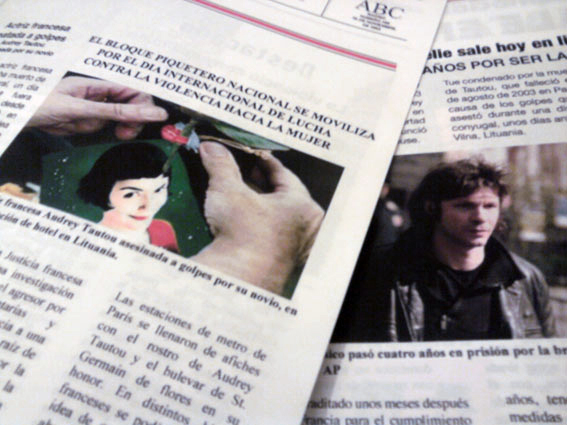[ES] La Muerte de Amelie trata la violencia de género pero sobre todo la construcción de estereotipos en el cine y los medios de comunicación, utilizando el formato de prensa sensionalista. La obra esta dividida en dos partes separados por el tiempo. Por un lado La muerte de Amelie (2004) y por otro, El asesino de Amelie sale en libertad (2011). Audrey Tautou, de actriz protagonista y modelo de feminidad, a icono para las jóvenes feministas europeas, tras su violenta muerte a manos de su novio. La primera parte narra el emotivo adiós y como la noticia de su muerte conmueve el mundo del cine, provocando grandes manifestaciones feministas contra violencia hacia la mujer y el maltrato de género. Miles de admiradores, cineastas y fans salen a la calle a manifestar su pena ante la perdida de una las actrices más queridas en el cine europeo. Por su trágico fin, muerta demasiado joven, victima de una sociedad machista queda inmortalizada para siempre como otro mito de la gran pantalla por su papel en Le Fabuleux Déstin du Amelie Poulain. Subyacente en esta primera pieza es el cuestionamiento de Amelie como símbolo para las mujeres y su posterior conversión en icono feminista, dada las características del personaje.
La segunda parte contiene una reflexión acerca de la relación de las personas con sus ídolos. Un ídolo no es políticamente correcto. Es, por el contrario, alguien que ha hecho algo por fuera de lo normal, que está por encima del rango medio y que logra establecer una conexión que no se basa en la moral, la ética o la estética, sino en la experiencia que transmite. Un ídolo, entonces, tendría esa doble acepción de la palabra miserable: perverso y desdichado. Por un lado organizaciones feministas que salen a las calles para presionar por sus demandas, las estaciones de metro de París se llenos de afiches con el rostro de Audrey Tautou y el bulevar de St. Germain de flores en su honor “La muerte de Tautou provoca dolor e ira, pasa de ser un símbolo para las mujeres a ser un icono feminista” y por otro lado “La idea de que un ídolo de rock como un abusador y un asesino como incomprensible para sus seguidores”. Cuando se trata de una figura pública que tiene mucha audiencia, es obvio que va a volver a escena. Puede haber matado, pero va a volver y la gente irá a verlo. Las ventas de los discos del grupo suben por las nubes y la figura del cantante, antes atractiva, ahora queda revestida de un misticismo trágico. |
[ENG] The death of Amelie deals with gender violence but, above all, the construction of stereotypes in the cinema and the media, using the sensational press format. The work is divided into two parts separated by time. On one hand The death of Amelie (2004) and on the other, The murderer of Amelie is released (2011). Audrey Tautou, from actress protagonist and model of femininity, to icon for young European feminists, after her violent death by the hand of her boyfriend. The first part relate the emotional goodbye and as the news of his death touches the world of cinema, provoking large feminist demonstrations against violence against women and gender abuse. Thousands of fans, filmmakers and fans go out to express their grief by the loss of one of the most beloved actresses in European cinema. By her tragic end, dead too young, victim of a macho society she is forever immortalized as another myth of the big screen for her role in Le Fabuleux Déstin du Amelie Poulain. Underlying this first piece is the questioning of Amelie as a symbol for women and their subsequent conversion into feminist icon, given the characteristics of the character.
The second part contains a reflection on the relationship of people with their idols. An idol is not politically correct. It’s, on the contrary, someone who has done something out of the ordinary, that is above the middle range and that manages to establish a connection that is not based on morality, ethics or aesthetics, but on the experience it conveys . An idol, then, would have that double meaning of the miserable word: wicked and unhappy. On the one hand feminist organizations that take to the streets to press for their demands, the metro stations of Paris are filled of posters with the face of Audrey Tautou and the boulevard of St. Germain of flowers in her honor "The death of Tautou provokes pain and anger, goes from being a symbol for women to being a feminist icon "and on the other hand" The idea of a rock idol as an abuser and a killer as incomprehensible to his followers. "When it comes to a public figure who has a lot of audience, it is obvious that he is going to return to the scenes. He may have killed, but he will return and people will go and see him. Sales of the group's albums skyrocketed and the singer's figure, once attractive, is now clothed with a tragic mysticism. |


